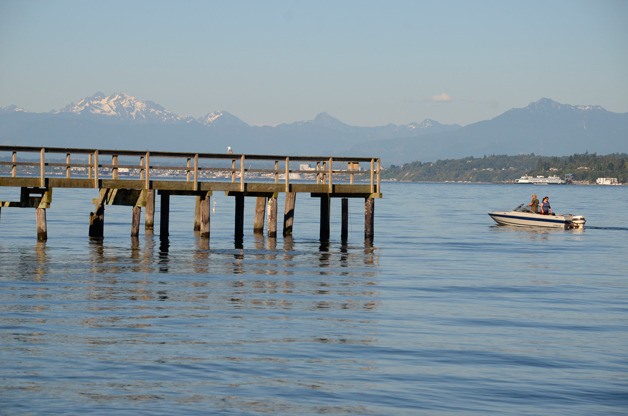Acquiring key shoreline properties in Glendale for public use will mean the removal of an existing concrete boat launch and an over-water pier.
Whidbey Camano Land Trust officials confirmed this week that funding issues have left the organization with little choice but to demolish the over-water structures, particularly the boat launch. The end result will be 420 feet of shoreline secured for public use, but property restricted to non-motorized use only.
“It’s choosing between having nothing there or having public access with some boat launch ability [kayaks],” said Pat Powell, executive director of the land trust. “There were no clear choices with this project.”
Public response to the news has been mixed. Some say it’s simply the price to pay for public access, one that should be happily paid.
“To give a little to get a little, that’s fine,” said Mike Thompson, a Glendale resident who uses the boat launch and has been a voice of support for securing the properties for public use. “To me it’s certainly worth it.”
Yet other residents are scratching their heads over the development.
“I think that would be a mistake not to preserve the boat launch just for money,” said Bud Kovic, another Glendale resident who uses the facility.
“I don’t know why they’d take out infrastructure they’d never put back in,” he added.
Earlier this year the land trust began working to purchase and preserve three separate waterfront properties: one that houses the old Glendale Hotel and the pier, an adjacent parcel with a house and boat launch, and a third undeveloped property just south of that. The total project cost, including land purchases, demolition — the hotel and the house would also be torn down to make way for parking — and miscellaneous property work is estimated at $1.5 million.
According to Powell, the pier is old and constructed with creosote pilings. It’s currently closed, and renovation to make the structure safe would top $200,000. It has limited use, said Powell, and is a source of pollution so the decision was made to remove it.
As for the boat launch, the project is being funding largely with two state grants, about $900,000, that are being applied for by Island County. Powell said the initial plan was to preserve the facility, but the grants do not allow motorized use, which means the ramp has to go.
“None of those grant sources allow motorized boats, they absolutely prohibit it,” Powell said. “There’s no other funding source the land trust or the county could find. It’s kind of a thing where, do you want the shoreline open to the public or do we let that opportunity go. We had to really weigh that.”
“The consensus was it was more important to get public access to this area … rather than walking away from the deal,” Powell said. “It was a tough decision and we spent quite a bit of time on it.”
Mike McVay, founder of Island Beach Access, said he doesn’t like the idea of losing two hard-to-replace over-water structures and hopes an alternative can be found. The boat launch and pier are some of the primary reasons the properties were eyed for preservation in the first place, he added.
“I’ll be really disappointed if those are the terms in which those properties are acquired,” McVay said.
Kovic said he has other concerns about the purchases, largely related to enforcement of usage hours. He worries that he’d be forced into policing his beachfront property from trespassers and mischief makers. His home was nearly destroyed in the 1970s from a beach fire that spread up the bluff.
Other neighbors have concerns about traffic jams, crime, liability and destruction from Mother Nature. The pier currently shields some bulkheads from storm-driven driftwood coming from the south.
Powell said the land trust will be meeting with residents at a community meeting later this month to address such concerns.
As for the land purchases, she said one of the properties — the undeveloped parcel — has been secured and the rest are expected to close in September. All remain closed for public use, however, for safety reasons. The hope is to complete the project in the spring of 2016.
Powell added the state grants planned to pay for the project are not guaranteed. The organization is funding the purchases with upfront money, and paying for everything else — about $600,000 — with loans. It’s a financial risk for the organization, but she said she believes the end result will be worth it.
The land trust will own and maintain the property, leaving the county free of obligation. The partnership is a model for other cash-strapped governments around Puget Sound, she said.
“I think it’s one of the most innovative partnerships that I’ve seen … hopefully it will catch on in other places,” Powell said.
An earlier version of this story inaccurately reported that 240 feet of shoreline would be preserved with the property purchases. The correct amount is 420 feet.



